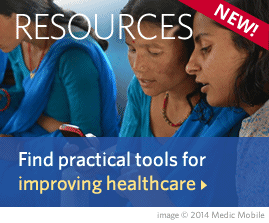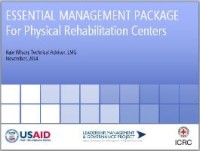
The Essential Management Package (EMP) is a toolkit of proven leadership development approaches that has been tailored for use by physical rehabilitation centers or other organizations providing services to persons with disabilities. It consists of the following components: (1) The Essential Management Systems Assessment Tool (EMSAT) and User Guide: a participatory assessment tool organizations can use to evaluate the state of development of their core management systems; (2) The Essential Management Systems Manual: a standardized model for procedures to strengthen management processes and systems; and (3) EMP Leadership Development Modules: a 10 module series of 4-hour leadership development and problem solving sessions that has been adapted from MSH’s proven Leadership Development Program Plus.
Read More...

Using the Standard Dashboard can help to enhance reporting processes and management for an overall improvement in organizational performance, reduce the volume of data information targeted at an overwhelmed manager, and promote timelier decision-making. The Dashboard Tools are used to assess whether enough organizational and IT capacity is present to support a Dashboard, and if so how to set up the first dashboard and organize the data collection and reporting process.
Read More...
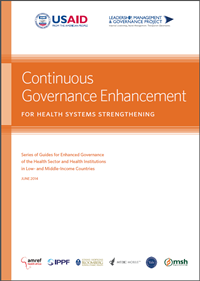
Good governance involves constantly striving for better results and improved effectiveness. It requires an interest in and commitment towards continuous improvement. In this guide, you will learn what actions you could take in your organization to improve its governance on continuing and long-lasting basis.
Read More...
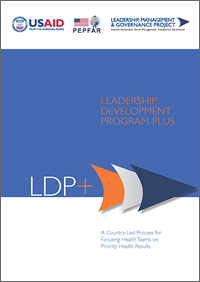
The Leadership Development Program Plus (LDP+) is the enhanced version of the Leadership Development Program (LDP), first delivered by Management Sciences for Health (MSH) in 2002. It is a team-based, results-oriented, participatory leadership development process that enables teams to face challenges and achieve results through a process of action-based learning. Individuals from the same workplace form teams to learn and apply leadership, management, and governance practices to improve a common set of health indicators.
The LDP+ Facilitator’s Guide is for facilitators to use and learn from as they implement the LDP+. It presents the foundations of the program and explains how to conduct all the necessary activities. It is designed to be easy-to-use and adaptable to the specific needs of an organization or LDP+ Improvement Team. The guide includes background information on the LDP+; Detailed instructions on how to conduct all LDP+ meetings and workshops; and handouts for participants.
Read More...

To strengthen midwives’ abilities to overcome health system challenges and deliver improved services, the USAID-funded Leadership, Management & Governance project developed the LMG for Midwifery Managers certificate course. This course consists of a five-day offsite workshop focused on six areas prioritized by a skills gap assessment: assertive communication, advocacy, mentoring, data use for decision-making, change management, and strategic problem solving.
Read More...
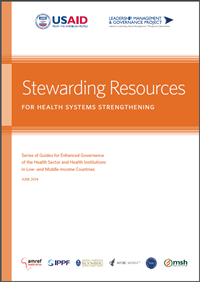
Stewardship is the ethical use of common resources in pursuit of financially efficient outcomes. This guide explores the nature of the practice of stewarding scarce resources (human, financial, political, and technological), and principles and activities that will strengthen your organization’s capacity for such stewardship.
Read More...
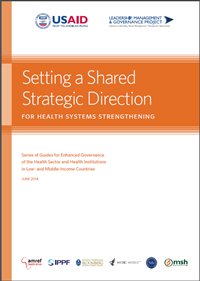
The leaders who govern determine the organization’s strategic direction and policies. They set out the organization’s strategic direction to deliver its mission, goals, and objectives. In this guide, you will learn how to set shared strategic direction for your organization working with your stakeholders and more importantly how to realize it again working with the stakeholders.
Read More...
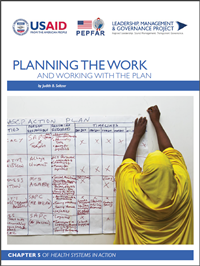
This publication attempts to simplify planning by introducing and defining a range of essential long- and short-term planning processes that managers of health programs or health services should implement. We focus on the primary organizational planning process: the development of a strategic plan and its conversion into an operational plan. The chapter sets the stage with a discussion of strategic thinking and then covers each phase of the strategic planning process: analyzing the organization’s internal and external environments, articulating or refining a mission, creating a vision, establishing strategic objectives, formulating strategies, and monitoring and evaluating results.
Read More...
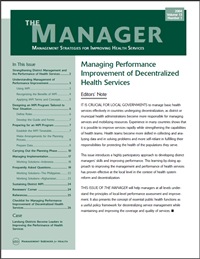
This issue of The Manager will help managers at all levels understand the principles of the local-level performance assessment and improvement. It also presents the concept of essential public health functions as a useful policy framework for decentralizing service management, while maintaining and improving the coverage and quality of services.
Read More...
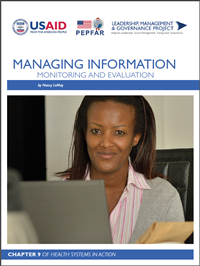
This publication is a practical guide that you, the manager of a health program or of health services, can use to understand and organize essential practices that will improve the monitoring and evaluation (M&E) of health services. It explains the role and function of an effective health information system (HIS). It describes monitoring and evaluation as key program management functions, explains the difference between the two, and offers considerations for making each function more useful to you for learning and action. It also shows how good leadership and management practices are relevant to M&E. (This publication is Chapter 9 of Health Systems in Action: An eHandbook for Leaders and Managers.)
Read More...












